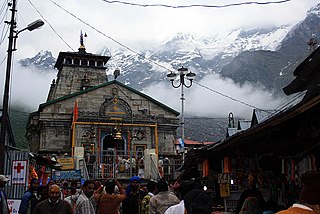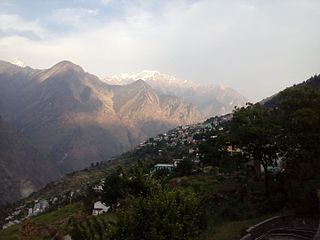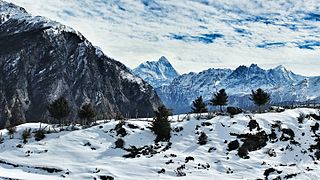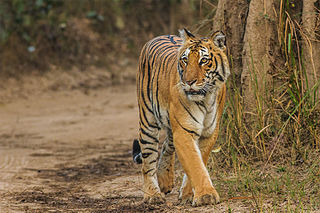
Kumaon is a revenue and administrative division in the Indian State of Uttarakhand. It spans over the eastern half of the state and is bounded on the north by Tibet, on the east by Nepal, on the south by the state of Uttar Pradesh, and on the west by Garhwal. Kumaon comprises six districts of the state: Almora, Bageshwar, Champawat, Nainital, Pithoragarh and Udham Singh Nagar.

Garhwal is one of the two administrative divisions of the Indian state of Uttarakhand. Lying in the Himalayas, it is bounded on the north by Tibet, on the east by Kumaon, on the south by Uttar Pradesh state, and on the northwest by Himachal Pradesh state. It includes the districts of Chamoli, Dehradun, Haridwar, Pauri Garhwal, Rudraprayag, Tehri Garhwal, and Uttarkashi. The people of Garhwal are known as Garhwali and speak the Garhwali language. The administrative center for Garhwal division is the town of Pauri. The Divisional Commissioner is the administrative head of the Division, and is a senior Indian Administrative Service officer. As the administrative head of the division, the Commissioner is overall incharge of the 7 districts in the Garhwal region of Uttarakhand, and is aided in his duties by an additional commissioner and the district magistrates. Sushil Kumar is the divisional commissioner of the Garhwal Division since December 2021.

Veerashaivism is a sect within the Shaivism fold of Hinduism. According to tradition, it was transmitted by Panchacharyas,, or five acharyas: Renukacharya, Darukacharya, Ekorama, Panditharadhya, Vishwaradhya, and first taught by Renukacharya to Agastya, a Vedic seer. The preachings of Jagadguru Renukacharya Bhagavadpada to rishi Agastya is recorded in the form of a book, Shri Siddhantha Shikhamani, which is regarded as an important holy book for the Veerashaivas. This text is likely a 8th century work, and it likely contains the earliest reference to Veerashaivism in literature.

Dehradun is the capital and the most populous city of the Indian state of Uttarakhand. It is the administrative headquarters of the eponymous district and is governed by the Dehradun Municipal Corporation, with the Uttarakhand Legislative Assembly holding its winter sessions in the city as its winter capital. Part of the Garhwal region, and housing the headquarters of its Divisional Commissioner. Dehradun is one of the "Counter Magnets" of the National Capital Region (NCR) being developed as an alternative center of growth to help ease the migration and population explosion in the Delhi metropolitan area and to establish a smart city in the Himalayas. It is the third largest city in the Himalayas after Kathmandu and Srinagar.

The Treaty of Sugauli, the treaty that established the boundary line of Nepal, was signed on 4 March 1816 between the East India Company and Guru Gajaraj Mishra following the Anglo-Nepalese War of 1814–16.

Joshimath, also known as Jyotirmath, is a city and a municipal board in Chamoli District in the Indian state of Uttarakhand. Located at a height of 6150 feet, it is a gateway to several Himalayan mountain climbing expeditions, trekking trails and pilgrim centres like Badrinath. It is home to one of the four cardinal pīthas established by Adi Shankara.

The folk music of Uttarakhand refers to the traditional and contemporary songs of Kumaon and Garhwal regions in the foothills of Himalayas. This music has its root in nature and the hilly terrain of the region.

Uttarakhand, also known as Uttaranchal, is a state in the northern part of India. It is often referred to as the "Devbhumi" due to its religious significance and numerous Hindu temples and pilgrimage centres found throughout the state. Uttarakhand is known for the natural environment of the Himalayas, the Bhabar and the Terai regions. It borders the Tibet Autonomous Region of China to the north; the Sudurpashchim Province of Nepal to the east; the Indian states of Uttar Pradesh to the south and Himachal Pradesh to the west and north-west. The state is divided into two divisions, Garhwal and Kumaon, with a total of 13 districts. The winter capital of Uttarakhand is Dehradun, the largest city of the state, which is a rail head. Bhararisain, a town in Chamoli district, is the summer capital of Uttarakhand. The High Court of the state is located in Nainital.

Almora is a district in the Kumaon Division of Uttarakhand state, India. The headquarters is at Almora. It is 1,638 meters above sea level. The neighbouring regions are Pithoragarh district to the east, Chamoli district to the west, Bageshwar district to the north and Nainital district to the south.

Haldwani is the largest city of Kumaon. It is also the third most populous city and largest commercial market in the Indian state of Uttarakhand. Haldwani is said to be the financial capital of Uttarakhand, having the most commercial, economic and industrial activities of the state. Haldwani is located in the Nainital District, and is one of its eight Subdivisions. The Haldwani Urban agglomeration has 232,060 people as of 2011, and is the third most populous UA in Uttarakhand, after Dehradun and Haridwar. Being situated in the immediate foothills of Kumaon Himalayas, the Kathgodam neighbourhood of Haldwani is known as the "Gateway to Kumaon".

Badrinath or Badrinarayana Temple is a Hindu temple dedicated to Vishnu. It is situated in the town of Badrinath in Uttarakhand, India. The temple is also one of the 108 Divya Desams dedicated to Vishnu - holy shrines for Vaishnavas - who is worshipped as Badrinath. It is open for six months every year, because of extreme weather conditions in the Himalayan region. The temple is located in Garhwal hill tracks in Chamoli district along the banks of Alaknanda River. It is one of the most visited pilgrimage centers of India, having recorded 2.8 million visits in just 2 months in 2022.

Uttarakhand is a state in North India. Its name, which means "northern land" or "section" or "northern part" in Sanskrit, is mentioned in early Hindu texts as the combined region of Kedarkhand and Manaskhand.
Traditional witchcraft is a term used by certain esotericists who regard their practices as forms of witchcraft. The unifying feature of these religious movements is the attempt to differentiate themselves from the modern Pagan new religious movement of Wicca, whose followers typically call themselves witches, by emphasising "traditional" roots. Among traditions that have repeatedly been termed "traditional witchcraft" are Victor Henry Anderson's Feri Tradition, Robert Cochrane's Cochrane's Craft and Andrew D. Chumbley's Sabbatic Craft.
Buksa, also known as Buksari and Bhoksa, is an Indo-Aryan language spoken by the Buksa people in parts of Uttarakhand and Uttar Pradesh, India.
Education in Uttarakhand is provided by various public and private institutions. Uttarakhand had a long tradition of learning and culture.
Yashodhar Mathpal is an Indian archaeologist, painter, curator, Gandhian and Rock art conservationist. He is most known for his study of cave art, especially in Bhimbetka rock shelters, Barechhina (Uttarakhand) and Kerala. He founded the Folk Culture Museum in Bhimtal, Nainital district, in 1983.

Pritam Bhartwan is a folk singer from Uttarakhand, India. In 2019, he was conferred the Padma Shri honour by the president of India, Ram Nath Kovind, for his contribution to the field of traditional folk art. He also known as jagar Samrat in Uttarakhand. He has received many awards by State government and central government. He is also visiting professor in Cincinnati University and University of Illinois University.
Pandav Lila or Pandav Nritya is a ritual re-enactment of stories from the Hindu epic Mahabharata, through singing, dancing and recitation, that is practised in the Garhwal region of Uttarakhand, India. Pandavas are the five protagonists in the epic and the village amateurs take on their roles and perform the lila outdoors, accompanied by the folk instruments dhol, damau and two long trumpets called bhankore. The performances, which can last anywhere from three days to a month in different villages, draw large crowds and are an important cultural highlight of the year. The ritualistic drama features actors who often spontaneously become "possessed" by the spirits of their characters and begin to dance.

Aipan is an established-ritualistic folk art originating from Kumaon in the Indian Himalayas. The art is done mainly during special occasions, household ceremonies and rituals. Practitioners believe that it invokes a divine power which brings about good fortune and deters evil. The art is special as it is done on empty walls, which are brick-red in color, called Geru. The actual art is done with a white paste made of rice flour. The art is frequent to floors and walls of Puja rooms and entrances of homes. It is also practiced mostly by Kumaoni women. The art form has great social, cultural and religious importance.














